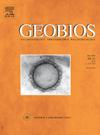Morphology and growth factors of the Cambrian oncoids in the Shuangquan section, China
IF 1.6
4区 地球科学
Q2 PALEONTOLOGY
引用次数: 0
Abstract
The strata of the Xuzhuang Formation in the Shuangquan section of the North China Platform show continuous outcrops with various oncoids that lack conspicuous laminates microscopically. This study offers a comprehensive analysis of the distinct oncoids present in the Xuzhuang Formation in the Shuangquan section. Macroscopically, the orientation of the long axis of the oncoids presents different angles with the bedding surface, indicating growth in a turbulent, high-energy environment. Microscopically, the oncoids can be classified into five types based on morphological disparities: suborbicular, elliptical, elongated, rod-shaped, and irregular oncoid, with the nucleus predominantly situated near the center of the oncoid in most instances. Notably, these oncoids reveal filamentous calcified cyanobacteria fossils. This suggests that oncoid formation is the intricate result of calcification processes within biofilms and microbial mats dominated by cyanobacteria. Microscopic examination also reveals residual microbial mats and eroded oncoids. As a result, it is posited that the proper hydrodynamic energy, incident light conditions, and microbial activity constitute the three principal factors driving oncoid development in the Shuangquan section. Consequently, our findings not only present a representative instance of the diversity of Cambrian oncoids on the North China Platform, but also allow for a better understanding of the environment and process of oncoid formation.
双泉剖面寒武系类瘤类的形态与生长因子
华北地台双泉剖面徐庄组地层为连续露头,形态各异,镜下无明显层状。本文综合分析了双泉剖面徐庄组独特的癌状类。宏观上,类瘤体长轴的方向与层理面呈不同角度,表明生长在湍流、高能环境中。镜下根据形态差异可分为近圆形、椭圆形、长条形、杆状和不规则五种类型,多数结节核位于中心附近。值得注意的是,这些癌状体揭示了丝状钙化蓝藻化石。这表明,癌样的形成是复杂的结果钙化过程在生物膜和微生物席主导的蓝藻。显微镜检查还发现残留的微生物席和侵蚀的癌样。综上所述,适宜的水动力能、入射光条件和微生物活性是驱动双泉剖面瘤体发育的三个主要因素。因此,我们的发现不仅提供了华北地台寒武系类瘤多样性的代表性实例,而且有助于更好地了解类瘤的形成环境和过程。
本文章由计算机程序翻译,如有差异,请以英文原文为准。
求助全文
约1分钟内获得全文
求助全文
来源期刊

Geobios
地学-古生物学
CiteScore
3.30
自引率
6.20%
发文量
28
审稿时长
6-12 weeks
期刊介绍:
Geobios publishes bimonthly in English original peer-reviewed articles of international interest in any area of paleontology, paleobiology, paleoecology, paleobiogeography, (bio)stratigraphy and biogeochemistry. All taxonomic groups are treated, including microfossils, invertebrates, plants, vertebrates and ichnofossils.
Geobios welcomes descriptive papers based on original material (e.g. large Systematic Paleontology works), as well as more analytically and/or methodologically oriented papers, provided they offer strong and significant biochronological/biostratigraphical, paleobiogeographical, paleobiological and/or phylogenetic new insights and perspectices. A high priority level is given to synchronic and/or diachronic studies based on multi- or inter-disciplinary approaches mixing various fields of Earth and Life Sciences. Works based on extant data are also considered, provided they offer significant insights into geological-time studies.
 求助内容:
求助内容: 应助结果提醒方式:
应助结果提醒方式:


